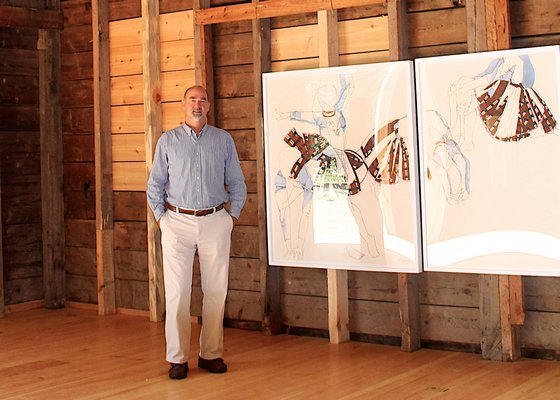
Things are looking bright for historic John Little Studio in Springs, which opened to the public in mid-July with a painting and sculpture exhibition by Sydney Albertini.
Mr. Little, an abstract expressionist, had purchased the late-19th century barn from the Gardiner family to serve as his art studio, and purchased the 7.5-acre parcel from the Edwards family, who owned 130 acres, in 1948. His former studio is located in a barn at what used to be Duck Creek Farm, which East Hampton Town purchased with Community Preservation Fund money in 2006.
Beginning in January 2016, the building was significantly restored in hopes for use as a gathering place for cultural engagement, and the studio now sports new pineboard floors and even public restrooms.
East Hampton Town Councilman Peter Van Scoyoc said that after raising his family in East Hampton, it became difficult for him to ignore several seriously neglected historic sites, and that taking care of them was one of the goals he had in mind when he was elected town councilman in 2012.
Mr. Van Scoyoc helped form the East Hampton Town Property Management Committee, which makes recommendations for the potential uses of town-owned properties, in 2014. The committee has since undertaken other preservation projects, including the Brooks-Park Studio in Springs and Fort Pond House in Montauk.
“The town had owned the property for six years at that point, and nothing had been done with it,” Mr. Van Scoyoc said of the condition of the John Little Studio when he took office. “It basically became a de facto storage building for the town. It was literally stacked to the rafters with old desks and computer screens, beetles had infested the floorboards and wooden beams underneath, the roof was leaking, and we even had raccoons living there.”
He went on, “It was important to restore the structure as it was originally. Part of the historic nature of the structure was not just being a Civil War-era barn that was owned by the Gardiner family, but also the connection of John Little to abstract expressionist art. It seemed logical to keep both those histories in mind.”
Mr. Little, among many other East End artists like Jackson Pollock and Willem de Kooning, was recognized for sparking the abstract expressionist art movement in Springs in the mid 20th century, according to Mr. Van Scoyoc. Keeping in tune with the studio’s history, future plans for the property include art exhibitions, community programs and free concerts featuring local musicians, the first of which will feature Inda Eaton from 5 to 7 p.m. on Saturday, August 26.
These programs are developed by the committee’s partner, Peconic Historic Preservation Inc.
“It’s a beautiful setting,” Van Mr. Van Scoyoc said. “The barn has large, rolling doors so it becomes sort of a bandshell, which really opens it up for poetry readings, concerts or something like Shakespeare in the park. It adds a whole new dimension.”
The Duck Creek Farm property is also home to Mr. Little’s former residence, which Mr. Van Scoyoc hopes to tackle next. For now, the councilman hopes people will take advantage of the former John Little Studio and its extensive property on the corner of Three Mile Harbor and Squaw roads in Springs. As the first restoration project completed with the committee’s support, Mr. Van Scoyoc considers it a job well done.
“It’s really come back to life,” he commented. “When you walk on the property, you’re really taken back to the 18th century.”
For more information about the studio, visit preservepeconic.org.